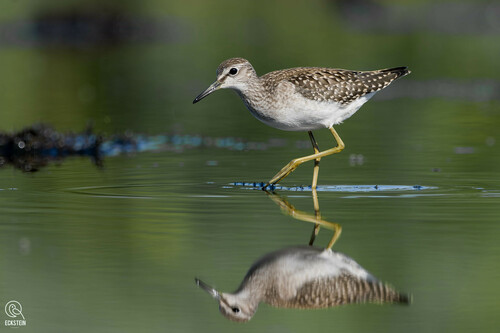
Wood Sandpiper
The Wood Sandpiper (Tringa glareola) is a small, elegant wader known for its graceful movements and distinctive calls. It plays a vital role in wetland ecosystems, primarily as a predator of invertebrates. While not possessing any widely recognized cultural significance, it is a welcome sight for birdwatchers across its vast breeding and wintering ranges, indicating healthy wetland habitats. Its agility and subtle beauty make it a fascinating subject of study for ornithologists.
19-23 cm
Length
36-41 cm
Wingspan
Least Concern
Conservation Status
Distribution
Breeds across subarctic and temperate regions of Eurasia, from Scotland in the west to Siberia and Kamchatka in the east. Migrates south to winter in Africa, South Asia, Southeast Asia, and Australia. Altitudinal range varies from sea level to mountainous regions, particularly during migration.
Lifespan
Average lifespan in the wild is estimated to be around 4-8 years, although some individuals may live longer.
Wood Sandpiper's Habitat
Habitat Types
Freshwater marshes, Bogs, Swamps, Flooded meadows, Lake edges, Riverbanks, Rice paddies (during migration and winter)
Climate Zones
Temperate, Subarctic, Tropical (during migration and winter), Subtropical (during migration and winter)
Adaptations
The Wood Sandpiper's long legs and bill are well-suited for wading in shallow water and probing for prey in mud and soft substrates. Its relatively long toes help distribute its weight, preventing it from sinking into soft mud.
Variations
No widely recognized subspecies exist, although minor plumage variations may occur across its extensive range. These are generally considered clinal variations rather than distinct subspecies.
Appearance
Breeding Plumage
Breeding plumage features dark brown upperparts with prominent white speckling, a streaked breast, and a white belly. Non-breeding plumage is duller, with less distinct streaking and spotting.
Seasonal Feather Changes
Moults occur twice a year, resulting in the distinct breeding and non-breeding plumages. Juveniles resemble non-breeding adults but have buffier fringes to their feathers.
Sex Based Plumage Differences
Minimal; males and females have very similar plumage. Subtle differences may be present in the intensity of streaking or spotting, but these are not always reliable for sexing.
Notable Features
Long, greenish-yellow legs, Relatively straight, dark bill with a slightly paler base, Prominent white supercilium (eyebrow stripe), White rump and lower back, visible in flight, Dark, barred tail
Diet and Feeding
Primary Foods
Insects (adults and larvae), Spiders, Crustaceans, Molluscs, Small worms, Occasionally small fish and amphibians
Foraging Behavior
Typically forages by wading in shallow water or walking on mudflats, probing with its bill to capture prey. It may also pick prey from the surface of the water or vegetation. Often feeds actively, running and pecking quickly.
Specializations
Its long bill and tactile sensitivity allow it to detect and extract prey buried in mud or sand. Its long legs allow it to wade in deeper water than some other small waders.
Seasonal Diet Variations
Diet may shift depending on prey availability. During the breeding season, insects are the primary food source. In winter, the diet may include a wider variety of invertebrates and occasionally small vertebrates.
Behavior
Social Structure
Generally solitary or in small groups during the breeding season. Forms larger flocks during migration and on wintering grounds, sometimes numbering hundreds of birds.
Communication
A distinctive, high-pitched 'chiff-chiff-chiff' call, often given in flight, A more mellow 'teu-teu-teu' call, Alarm calls, including a sharp 'chip' or 'kip', Visual displays, such as wing-raising and tail-spreading during courtship
Migration
A long-distance migrant, traveling thousands of kilometers between breeding and wintering grounds. Migrates both day and night, often in loose flocks. Migration routes are complex and may vary depending on the breeding population.
Territorial or Group Behaviors
Territorial during the breeding season, defending the area around the nest. Outside the breeding season, generally not territorial and may form large feeding aggregations.
Conservation
Threats
Habitat loss and degradation (due to drainage of wetlands, agricultural intensification, and pollution), Climate change (affecting breeding habitat and migration routes), Hunting (in some parts of its range), Disturbance (from human activities)
Protection Programs
Protected under international agreements such as the Agreement on the Conservation of African-Eurasian Migratory Waterbirds (AEWA), Many important breeding and wintering sites are designated as protected areas (e.g., Ramsar sites)
Local National Laws
Protected under various national and local laws throughout its range.
Population Trend
Stable
Population Estimates
Global population estimated to be between 2,700,000 and 4,700,000 individuals.
Interesting Facts
They often bob their heads and bodies while foraging.
This behavior may help them to stir up prey or improve their visual perception of movement.
They are known for their agility and speed, both on the ground and in the air.
This allows them to evade predators and efficiently capture prey.
The Wood Sandpiper sometimes nests near, or even on top of old thrush nests.
While they typically create their own nests, this behavior demonstrates their adaptability.
Faqs about Wood Sandpiper
What is the difference between a Wood Sandpiper and a Common Sandpiper?
Wood Sandpipers have longer, greenish-yellow legs, a more prominent supercilium, and a different call. Common Sandpipers have shorter, duller legs and a characteristic bobbing motion.
Where can I see a Wood Sandpiper?
During migration, look for them in freshwater wetlands, marshes, and flooded fields. They are widespread but can be inconspicuous, so patience and careful observation are key.
Are Wood Sandpipers endangered?
No, the Wood Sandpiper is classified as Least Concern by the IUCN, meaning it is not currently considered to be at high risk of extinction. However, habitat loss and other threats continue to impact their populations.
Copyright @ Nature Style Limited. All Rights Reserved.
 English
English